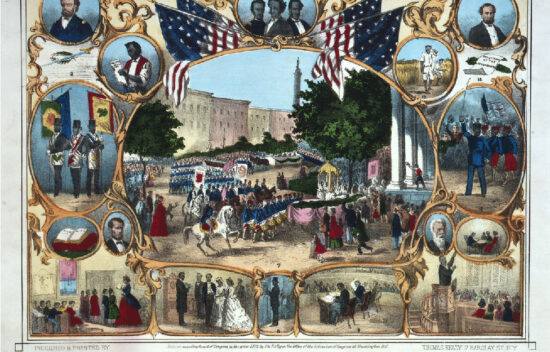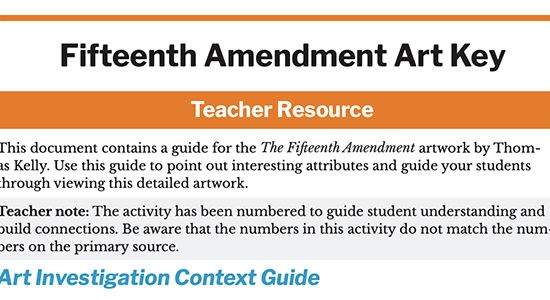
Comparing Art to Reality
Lesson Components
The Freedmen’s Bureau and the Challenges of ReconstructionGuiding Questions
- What were the experiences of African Americans during Reconstruction?
- How did Reconstruction impact the lives of formerly enslaved people and their families?
Objective
- Students will explain how Reconstruction impacted the lives and experiences of African Americans.
Student Resources:
Teacher Resources:
Facilitation Notes
- The number list on the Fifteenth Amendment Art Key Teacher Resource matches the numbers of the covered areas on the pre-made slide and gives the title and description of the image. This information is intended for teachers to bring context to images and support conversation. Be aware that the numbers in this activity do not match the numbers on the primary source.
Engage
- Display the image “Glimpses at the Freedmen- The Freedmen’s Union Industrial School, Richmond, VA” from Jas E. Taylor (1866). Ask students the following questions
- Describe what you see.
- Does this seem like a traditional school? Why or why not?
- What do you think it means by “industrial school”?
- What do you notice about the “students”?
- What do we know about the time period in which this art was created?
- Transition: Tell students: Today we will look at another piece of art, read a short essay, and then compare the two. We will be investigating the conditions that African Americans hoped Reconstruction would bring about and how Reconstruction impacted the lives of formerly enslaved people and their families.
Explore
- Display The Fifteenth Amendment artwork from Thomas Kelly for students to see from the premade and numbered slide. Starting in the center, ask students to describe what they see. Then remove the numbered covers from each area of the image.
Scaffolding Note: If time or student attention is short, select scenes from the piece rather than looking at all eighteen pieces. Choose 5-7 areas to look at in depth, then discuss them as part of the whole image. For instance, a teacher might choose to focus on items 4, 6, 7, 11, 14, 17, and 18 to bring attention to the changing lives of Black Americans.
- After uncovering and discussing the image, ask the following reflection questions. You may want to post or print the complete artwork for students to view while they answer.
- How does this source show the hope and promise of Black freedom?
- What kinds of things does the artist see for the future of Black people now that they have the rights of citizenship?
- Which areas of the primary source show Black Americans enjoying their natural rights?
- Which areas of the primary source show justice for formerly enslaved Black Americans?
- Consider the whole image. What is the artist trying to tell us?
- Transition: Handout out The Freedmen’s Bureau and Challenges to Reconstruction Essay. There are two reading options.
- Ask students to compare how the essay differs from the image. Use the following questions to help guide the discussion:
- Did the image match O.O. Howard’s view of Reconstruction? How so or why not?
- In what areas did the image seem to come true according to the essay reading?
- In what areas did the image seemingly not become reality according to the essay reading?
Assess & Reflect
- Reflection:
- O.O. Howard was nicknamed by some as “Uh-oh” Howard for his less-than-perfect performance as a military leader. Reconstruction was also less than perfect. Would you consider Reconstruction to be an “Uh-oh” based on today’s lesson activities?
AND/OR
- Thesis with Evidence:
-
- Create a thesis and establish a line of reasoning to answer the prompt. Then provide at least two pieces of evidence that inspired the art to support your thesis.
- How successfully did Reconstruction impact the lives of formerly enslaved people and their families?
- Create a thesis and establish a line of reasoning to answer the prompt. Then provide at least two pieces of evidence that inspired the art to support your thesis.
